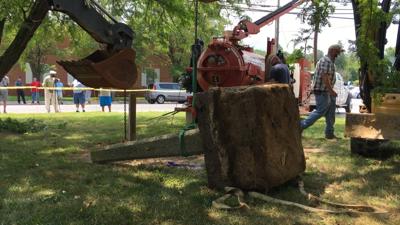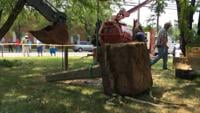GEORGETOWN, Del.- Delaware's last whipping post was removed from public display Wednesday morning, drawing a big crowd to the grounds of the Old Sussex County Courthouse in Georgetown. Its removal was years in the making and it comes in response to calls from people in the area because of its violence and connection to racial discrimination.
"I brought my 8-year-old daughter, my granddaughter. I wanted her to be witness today and it's a history lesson for her because she had never heard of a whipping post," Diaz Bonville of Sussex County says.
Delaware's Division of Historical and Cultural removed the post, also referred to as the Red Hannah. It is being held in a storage facility until historians can put it in a museum, where they say it will be better served.
"Knowing the history of it there because just seeing this, it doesn't give you any idea for instance of why it's called Red Hannah or it doesn't give you any history about which governor had them removed and all those things so put it in a museum," Dr. Reba Hollingsworth, vice-chair of the Delaware Heritage Commission, says.
Dr. Hollingsworth says she witnessed a public whipping when she was a child in Dover.
"He was shackled to the post, actually facing it like this, bare back, bare from the waist, down to the waist and this man was standing there with this cat o' nine tails and he was whipping him and count each whip," Dr. Hollingsworth recalls.
The whipping post was last used in Delaware in 1952 and outlawed in 1972. Delaware was the last state to abolish that punishment. Advocates say its removal is about educating others on some of the darkest parts of the nation's past.
"Never again. Never again should we see nooses or ovens or whipping posts or you know reminders of a painful era," Christy and Victoria Taylor of Sussex County say. "I agree we should recognize where they came from and their origins so we can learn. We should listen to young people now and see what the affect of these images gone will have for them. It's like a freedom. It's like a chain that's broken because the shame for all people, white and black, is that we never talked about it and yet we honor them by having them displayed."
Many who came out to see the post's removal also say it's a positive step towards change.
"It's really a part of history but it also means that we as a nation needs to come together and tear down some of the barriers and some of the negative artifacts that we see and here in Georgetown, we're seeing that today," Bernice Edwards of Georgetown says.
Bonville adds, "It's a window of opportunity to be our community unity, where it's not just a day where African Americans but also people of other races can see what African Americans had to go through to get where we are today."



